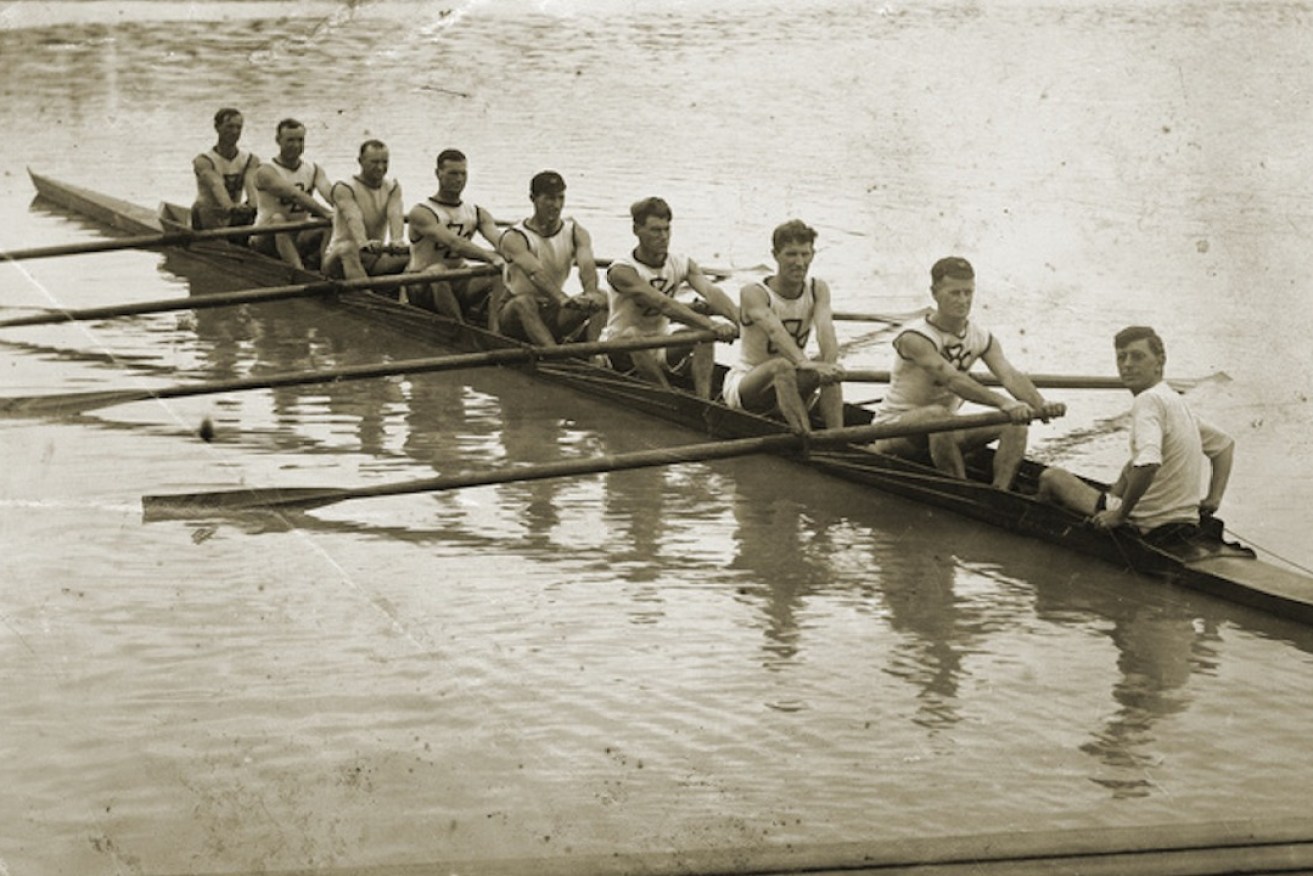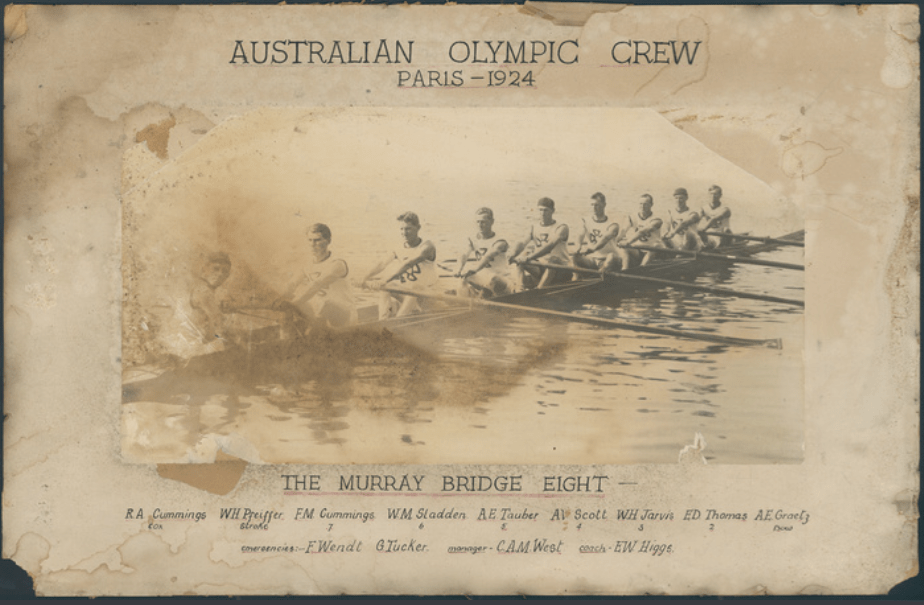The ‘raggedy’ small-town rowers who took on the world
The ‘Murray Cods’ rowing crew overcame class prejudice and interstate rivalry to compete on the world stage at the 1924 Paris Olympics, and are now being posthumously inducted into the South Australian Sport Hall of Fame.


The Murray Bridge Eight, known as the “The Cods”, took part in the Paris Olympics in 1924. SLSA B 60346
On a winter’s Saturday in 1909, a group of more than 30 individuals gathered at the Bridgeport Hotel in Murray Bridge to establish the Murray Bridge Rowing Club.
Not long after its formation, one of newly elected vice presidents of the club, Dr Macquarie, confidently declared that “the Murray Bridge Rowing Club will soon be amongst the senior clubs striving to be premiers of South Australia and probably gain international honours”.
As bold as his statement may have seemed, Macquarie had accurately predicted the future.
The Murray Bridge Rowing Club, or “the Murray Cods” as they were affectionately known, would become national champions and Olympic representatives competing against the best rowing teams in the world.
The crew’s various achievements included representing South Australia in the Eight Oar Championship of Australia for the first time in 1913, where they won the “Kings Cup” in 1920, 1922 and 1923 after reforming following World War I.
They also represented Australia at the 1924 Paris Olympics. One hundred years on, and in the lead-up to the return of the Olympic Games to Paris, the crew will be inducted into the South Australian Sport Hall of Fame on March 1.
The Murray Cods, described as “raggedy” in one newspaper, not only broke class barriers as a group of working-class men competing in this “elite” sport, but they also pioneered a new style of rowing that was not without its critics.
As working, rural men competing in a gentlemanly sport, the team had faced hostility from upper-class competitors in Sydney and Melbourne.
This opposition came to a head when, in 1913, the Amateur Rowing Association investigated accusations that members of the Murray Cods were in fact “professionals”, which according to the strict rules governing rowing included anyone who laboured for a living.
Yet in other ways, the Murray Cods’ outsider status favoured them. They were willing to pioneer a new “Murray River style” of rowing that was criticised by more conservative observers.
The new style used exaggerated body movements in stark contrast to the upright, stiff-backed position favoured by most rowers at the time.
One commentator in Adelaide’s Daily Herald accused the team of prioritising strength over style and wrote on February 18, 1913, that should the Murray Cods take on a first-class New South Wales or Victorian team, “[a]ssuming that both crews were equally fit, I should say that the race would be a vindication of the superiority of form first mentioned”.

The “Murray Cods” Olympic crew. SLSA B 70509
The path for the Murray Cods to the Olympics was not smooth in other ways, too.
In one unfortunate incident in 1923, the Returned Soldiers’ Association rallied against the inclusion of “stroke” Wally Pfeiffer in the crew because he had been a conscientious objector during WWI.
Writing in Sport Adelaide on Friday, November 2, 1923, one of his teammates wrote: “What the lcoal (sic) R.S.A has to do with the matter beats us, for Australia is entitled to be represented by the best men, irrespective of any pulling the strings. We don’t know, but we have a suspicion that the Victorian R.S. League is behind the action of the S.A. R.S.A., for the Victorians are dead against the Murray Cods representing Aussie at Paris next year.”
Among the other members of the Olympic team, five were returned soldiers, while other members of the original Murray Cods were either tragically killed or injured during the Great War or replaced due to their age or ability.
The team included a storekeeper, a carpenter, a postal assistant and a few firemen who worked for South Australian Railways.
The Murray Cods left Outer Harbor on the R.M.S Ormonde on May 8, 1924. The crew included E. Gaetz, E. Thomas, W. Jarvis, A. Scott, A. Tauber, W. Pfeiffer, F. Cummings, W. Sladden, R. Cummings, E. Higgs, G. Tucker and S. Wendt.
Describing the departure in his diary on May 8, 1924, Robert Cummings wrote: “Murray Bridge Crew representing Australia left Outer Harbor May 8th per R.M.S Ormonde, with the other Australian Athletes, Great send off at the Outer Harbor, leaving at 3p Ship sailed beautiful (sic).”
On board, the team amused themselves by playing card games, reading in the library, joining sports activities, watching silent movies, playing jazz music, attending fancy dress balls and training to keep in form.
“All sorts of games indulged in on board. Dancing in the evening, also card playing with plenty of music. The Ormonde is a beautiful boat, something like a first class hotel on water, everything to one’s comfort,” Cummings writes in his diary on May 10.
“Our lads did little exercise skipping & running. The other athletes did likewise to try & keep themselves fit while on the voyage over. Moving pictures were taken of our lads at practice, also the various athletes, they are a fine lot of men & good sports, jolly and pleasant.”
After arriving in Toulon on June 10, the team travelled to Paris to get into shape before the games. Cummings described Paris as “no doubt a wonderful city” and a “real eye opener” where “Parks & gardens are beautiful,” although he noted that: “The French language has still got us tricked seems strange to all.”
The team began training on the Marne River, which is located to the east and southeast of Paris.
“[B]orrowed 8 oar boat had good row up river. Beautiful stream but very much crooked course but very pretty,” wrote Cummings on June 13.
On June 20 he wrote: “Crew improving slowly, & I think fit in three weeks hence when we race.”
On the first race on Tuesday, July 15, the team performed poorly and they were eliminated the following day after losing to Canada.
“Rowing finished. Had hard luck did our best,” Cummings noted in his diary.
“The overwhelming and disastrous defeat of the Murray Bridge crew in Paris points to a moral which Australian oarsmen might well take to heart,” wrote another observer in the Register shortly after the crew’s defeat in Paris.
“The Murray Bridge crew, who did splendidly well for old men – ‘old’ in the rowing sense – handicapped by lack of first-class competition while being poorly boated and badly rigged.”
Yet despite the unfortunate result in Paris, the trip ended with a silver lining when Wally Pfeiffer won gold as an individual rower at the first Tailteann Games in Ireland on their return journey.
“A performance which avenged the Bridge crew’s defeat was the success of Pfeiffer in the senior sculls, in which he led from start to finish from Major Denroche (Lady Elizabeth Boat Club), winning by two lengths,” one commentator wrote in the Southern Cross on August 22, 1924.




